Many of our birds cannot find a suitable habitat in the wild. A bird-friendly garden provides food and suitable nesting sites all year round.
About three quarters of the bird species in Europe are threatened and are on the NABU Red List. Our lifestyle destroys the habitat of many birds – natural landscapes with forests, meadows and wetlands give way to residential areas or industrial plants. Our agriculture also threatens the birds: the vast fields offer them no protection, toxic pesticides and insecticides kill potential food and weaken their health. Because birds often cannot find suitable habitat in rural areas, gardens become havens. A bird-friendly garden can contribute to biodiversity.
In this article, you’ll learn:
- how to make your garden bird-friendly
- which plants are suitable
- how to properly maintain your bird-friendly garden
- how to make walls and terraces bird-friendly
- how to provide a suitable watering place for birds.
Finally, we answer the question of whether you should install nesting boxes and additionally feed the birds.
Contents
Designing a bird-friendly garden
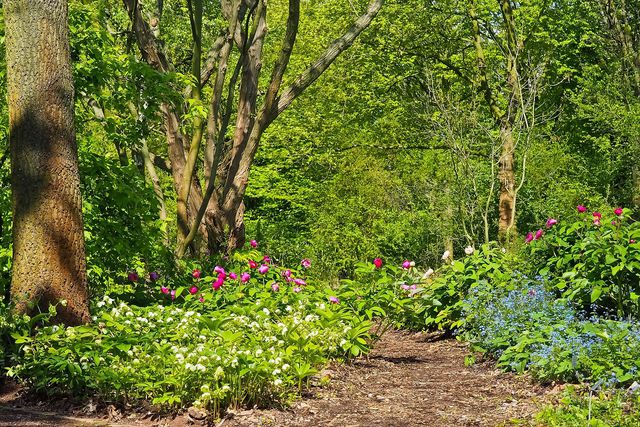
A bird-friendly garden should be as similar as possible to the natural habitat of the animals.
To do this, you should first familiarize yourself with the birds of your region: What species are there, what do they eat, how do they nest? Then you can design your garden so that they can find food and shelter all year round. The more varied and lush a garden is planted, the more it offers birds: Buds, seeds and fruits for food, foliage for shelter and nesting material.
Fruits and seeds are the most important food source for birds. They disperse many seeds, maintaining a healthy biodiversity.
Insects, spiders, snails and beetles are valuable food for young birds. An insect-friendly garden is a bird-friendly garden.
Foliage-rich plants provide shelter and nesting sites for birds: Shrubs, bushes, hedges, perennials and trees.
Varied planting attracts birds year-round.
Birds help you in the garden by eating insects and pests such as caterpillars or aphids. However, they also like fruits and flowers themselves. Bird-friendly gardening means leaving a portion of your harvest for birds – called bird tithes – and also thinking of your flowers primarily as useful rather than ornamental.
Tip: Observe the birds in your garden to learn about their needs. To do this, plan for an observation spot from which you can watch the birds without disturbing them.
Bird-friendly planting

The best way to imitate the natural habitat of birds is with native plants. A varied planting for as many bird species as possible is ideal. You can create a biotope with several levels, from a bird-friendly meadow to a nesting tree. If you have little room for maneuver in your garden or on your balcony, you can delight the birds with individual plants. Especially in winter, every food source counts.
- Birds use lawns to find insects and worms, and seeds from spring herbs like dandelions or clover provide food. Give plants enough time to form seeds before you mow. Avoid pesticides and weed killers on your lawn. Birds also enjoy ant burrows, bare patches of soil for dust bathing, and worms that are flushed up when you water.
- Wildflowers and grasses are a food source for birds. Leave them after they have faded – that way they form seeds that birds eat. Tall meadows also attract insects, snails, and mice or moles that provide food for raptors. For example, angelica, white goosefoot, yarrow, thistles, and ornamental grasses are suitable for flower meadows.
- Ground covers delight birds with seeds and insects. They grow densely and quickly, providing good cover. Suitable groundcovers include St. John’s wort, dwarf juniper, heather, honeysuckle, deadnettle, ivy, or wild strawberry.
- Flower beds provide nectar, flowers, fruits, and seeds for birds. In spring, for example, forsythia, blue rain, crocuses, primroses, violets, daisies, and forget-me-nots are suitable. Birds not only eat their seeds, but also aphids or slugs that are attracted to the flowers. Leave flowers after blooming to allow seeds and fruits to ripen. In fall, sunflowers, thistles, foxgloves, ornamental grasses, evening primrose, and barberry provide food for birds.
- Shrubs in deciduous and evergreen varieties provide shelter for birds and bear fruit, some of which hang on into winter. They are an important food source for birds. Shrubs also provide beautiful accents in the garden and are low maintenance. Bird-friendly shrubs include hazel, mahonia, snowball, barberry and firethorn.
- Hedges are ideal nesting sites and offer birds protection from cats or predators. They should be at least one and a half meters high and one meter wide. It is especially bird-friendly if you combine different hedge species – this way there will be flowers and fruits longer. Suitable hedges are sloes, hawthorn, elder, dwarf medlar as well as holly and privet with berries in winter.
- Climbing plants also create additional space in small gardens where birds can rest or find food. Bird-friendly climbers include clematis, passionflower, bindweed, wild vine, and ivy, which blooms only in fall and bears fruit in winter.
- Trees also provide places where birds can nest and sing undisturbed. The additional habitat also provides food: flowers, catkins, fruits and caterpillars. By the way, you can easily underplant a tree with wildflowers. Deciduous forest trees such as oaks, willows or poplars are best suited. Unsuitable are lime trees or yews.
- When choosing plants, pay attention to what fits into your garden. To do this, you should consider how large your garden is, what climate surrounds it and what the soil is like. It’s best to use a garden encyclopedia to find out what plants will suit your garden and how you can combine them to provide food for birds all year round.
Bird friendly gardening
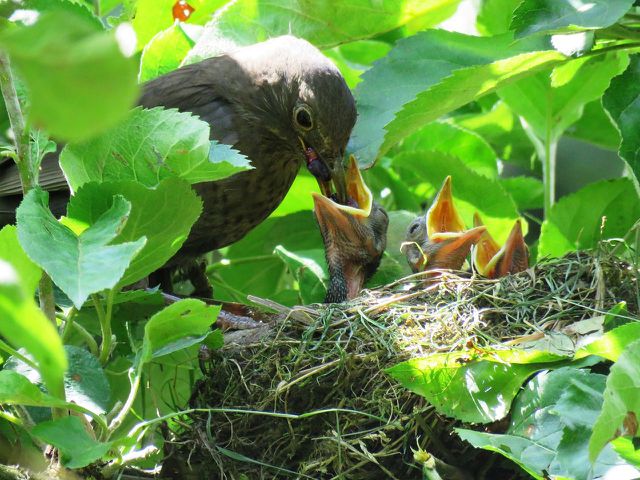
Birds like a slightly overgrown garden best. If you refrain from controlling weeds and pests, more food will remain for them. Dense foliage provides shelter for birds, where they can roost and nest.
- To ensure that your shrubs, bushes and trees have plenty of foliage, you should trim them regularly. This will keep the plants healthy and grow more densely.
- Cut back shrubs and hedges in late winter or early spring. This will preserve seeds as long as possible. It’s important to cut back your plants before birds nest in them. Check before each pruning to make sure this is the case.
- Prune shrubs and hedges alternately every two years. This allows them to bloom and provide food for birds on a rotating basis.
- Leave withered shrubs and flowers standing and dying. The seeds are important food for birds. Fruits should be left to ripen fully so birds can eat them.
- Weeds also provide food for birds. To keep them under control, you can hoe clover and bochshorn under or pull them out and leave them. You can regularly dig up weeds with deep roots such as goutweed, nettles, thistles, or blackberries.
- Pests such as caterpillars, slugs, aphids and larvae are valuable food, especially for young birds. However, if they become a nuisance, you can collect them or catch them with foil or tape and serve them to the birds.
- Chemical pesticides or insecticides fight the natural life of birds and have no place in a bird-friendly garden.
Designing a bird-friendly terrace, pergola and the like
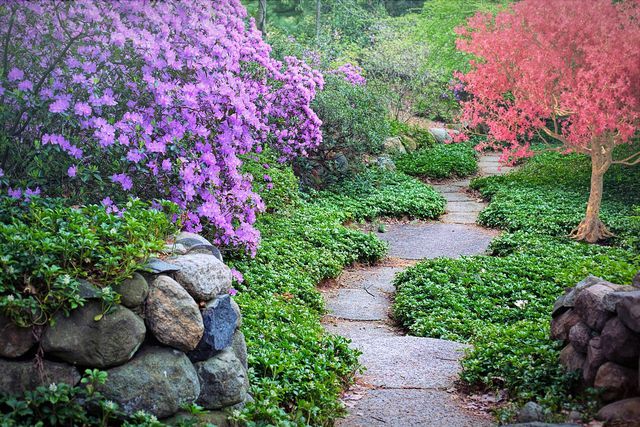
You can make even bare, non-green areas in your garden or on your terrace or balcony bird-friendly:
- Pergolas and trellises support climbing plants or serve as trellises for fruit trees. A trellis column provides nesting sites and food for birds – it’s a quick and easy alternative to a tree. It also protects birds from rain and wind.
- Rock gardens on slopes provide space for many plants that provide food for birds. Birds can also find food in stone crevices.
- Walls and slopes can be covered with climbing plants or ready-made planters. Some birds also nest in holes in walls.
- On a terrace, you can create a multi-level habitat: From hanging and climbing plants to raised beds to planters to herbs and potted plants. A bird feeder or bird bath can fit even on a small patio or balcony.
Bird-friendly watering holes in the garden
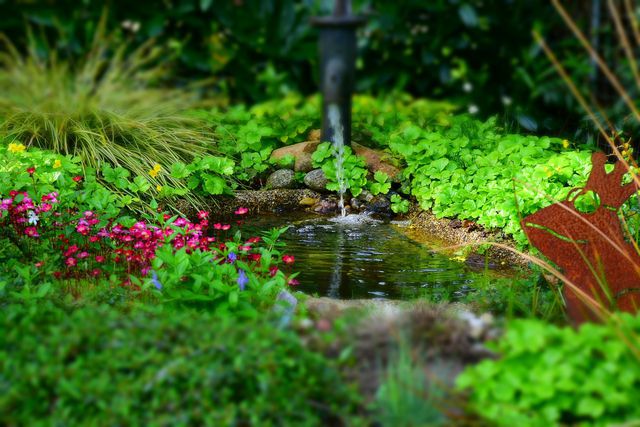
Birds need watering holes to drink, bathe, or soak their food. Water sources are especially important in winter: Natural springs are often frozen, but birds need plenty of water because they eat mostly dry seeds and fruits in winter.
- A simple water source in the garden is a bird bath, running water is even better. A natural watercourse, fountains or fountains provide birds with a steady supply of fresh water.
- Garden ponds and water gardens are even more popular with birds. These biotopes provide small aquatic animals, frogs and fish for food and attract special birds such as ducks or herons. Suitable plants for the pond and banks include purple loosestrife, marsh marigolds, irises, water lilies, bulrushes, pansies, primroses, ferns and hanging ivy. You can easily revive your pond with some water from another pond and release spawn in it. Water beetles, dragonflies and other insects will follow on their own.
Nesting boxes in the garden
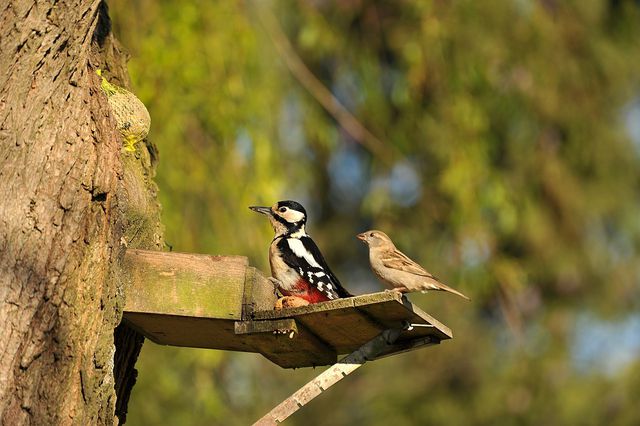
Nest boxes in gardens provide a refuge for birds that cannot find a natural nesting place. Bird species that nest in rare cavities, such as tits, starlings or nuthatches, benefit particularly from this.
Whether you build the nest box yourself or buy a ready-made one is up to you. However, make sure that it is of good quality and meets the needs of the birds. Again, observe the birds in your yard and choose a nest box that meets their needs. The nest box should be waterproof and preferably made of wood and impregnated non-toxic.
You recognize good nest boxes by:
- A removable roof, which makes it easier for you to clean the nest box,
- a sufficiently large and smooth flight hole,
- a rough bark that gives birds a foothold,
- a sloping roof that allows rain to run off.
- You should securely fasten the suitable nest box and check every year before the nesting season whether it hangs securely. You should also clean it every season and remove old nests. Birds often leave behind dead eggs or nestlings, diseases and parasites. Cleaning is important to prevent the next generation from becoming infected.
Tip: Birds are very picky when it comes to their nest. Therefore, find the nest box a sheltered spot that is easy to reach from flight. It may take three to four years for birds to accept the nest box.
Feed birds
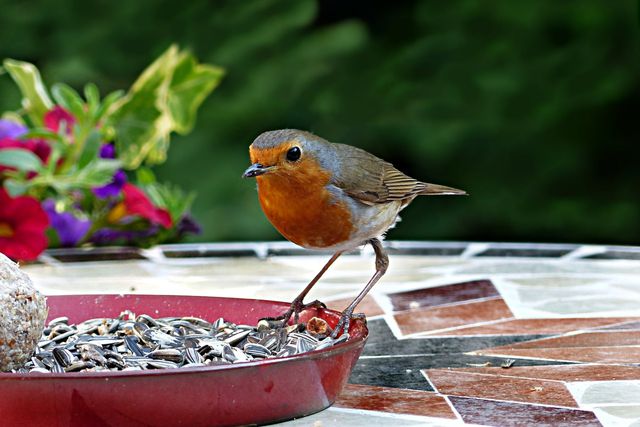
When and whether Natural food from bird-friendly plants is always better for biodiversity than fed food. According to NABU, backyard bird feeders attract only about ten to 15 bird species, most of which have stable populations. So endangered bird species hardly benefit. With a diverse, bird-friendly garden, you can attract far more bird species. However, supplemental feeding will not harm birds, even in the summer.
For your garden, you can only answer this question yourself. The best way to do this is to observe the birds in your garden: What birds are there, what needs do they have and does your garden meet these needs? If you notice deficiencies, you can either plant appropriate plants or feed them.
Always give only as much additional food as is actually eaten. Otherwise, you will attract rats and other small animals.
Find a safe feeding area. It should be at least six feet away from bushes.
Make sure the right birds eat the food. Larger birds can be kept away with coarse wire mesh. There are also special feeders for small birds with a grid that keeps larger birds out.









